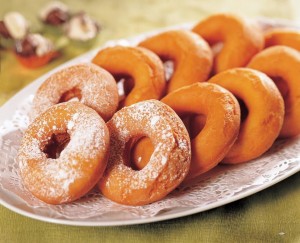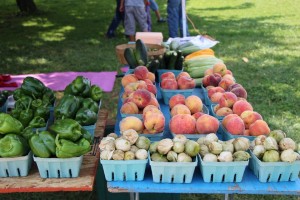*Disclaimer: This post contains affiliate links. That means, if you click one of the Amazon links and buy that item through my link, Amazon will pay me a small commission at no additional cost to you. This will help keep the recipes coming and I will say thank you. 🙂
When people find out that we “are paleo,” the first response out of their mouths is often, “Oh, I could never do that. Well, maybe I could, but not my whole family. Not with all the junk they like to eat.” Well, guess what, we ate junk too and we managed the transition just fine. You can too. To be honest, Oreos were an infrequent visitor to my pantry, and Twinkies never darkened our doorstep, but we do love chips. We always had those on hand. And ice cream in the freezer. We would eat fast food: french fries, onion rings, all that good stuff. Not all the time, but often enough that switching to a paleo lifestyle took some adjusting for sure.


I used to make homemade wheat bread. My recipe required the addition of gluten so that it would turn out like store bought bread. That just makes me laugh now to think that I used to ADD gluten to our food! Life is funny sometimes. I have always cooked the majority of our meals at home, but I didn’t pay much attention to the quality of my meat. About the best we did was buy organic produce according to the Dirty Dozen list.
My husband grew up with dessert after every lunch and dinner (or so he says) and I have yet to break him of that habit. He is a Type I diabetic, meaning his body does not make insulin anymore so he must inject it before meals. He has to carefully monitor his carbohydrate intake. Yet, he still loves his dessert. He wants ice cream, a cookie, some chocolate after every. single. meal. So he was thrilled when I started making some great paleo treats. There are a lot of treat recipes out there and a lot of them are very, very good. Even better than their non-paleo counterparts. Those who love gluten might not think so, but if you’ve transitioned even a little to this way of life, then you quickly learn that taking out all the junk = adding in lots of great flavors.
My husband was very supportive of ME making this transition, but I quickly realized that I could not and would not make two separate meals three times a day. The only way to make this work for me – to heal me (I realize that sounds selfish) – was if we all did it. Together. And so that’s what we did. I borrowed Diane Sanfillipo’s Practical Paleo from my local library, read the whole thing, cooked a few of the recipes and every one was delicious! So I bought the book and cooked all my meals from her book for months. If you are just starting out, I cannot recommend that book enough. The best thing about it for me was the fact that it was full of 30 day menus. I picked one and it told me what to cook for breakfast, lunch and dinner for a whole month. No, we did not follow it to the letter, but pretty close. I explained in my “about me” page more about this, so check that out if you want more details. Bottom line, it’s a great book and an invaluable resource for newbies.
Let’s get to the nitty gritty, shall we? How do we make this transition?

One thing I had to start doing if I was going to make this paleo thing work was plan, plan and plan some more. Breakfast was no longer a simple bowl of cereal, lunch couldn’t be a sandwich and we couldn’t pick up a pizza on a really harried night. So some time over the weekend, this is what I do:
- I sit down with a basic, old spiral bound notebook, my calendar, a pencil and my go-to cookbooks: Practical Paleo, Against All Grain, and the Autoimmune Paleo cookbook and of course, www.ourpaleofamily.com.
- I take an inventory of what kinds of protein I have in the freezer and how many fruits and veggies are left from the week, then I start planning out the meals.
- I make an effort to mix up the protein: one night beef, one night pork, one night chicken, one night fresh fish, one night canned fish, one night eggs. This ensures variety and also keeps costs in check.
- I need my calendar for this so I know which nights need to be quick, which days I can spend a couple hours cooking up a storm, and which days we just have to eat out due to activities. We have way over-committed ourselves on the extracurriculars this semester. If you non-homeschoolers ever question the sociability of homeschoolers, just talk to one and you will see that they get PLENTY of socialization. We have to work really hard to stay home!
- I plan out every breakfast, every lunch and every dinner for the entire week.
- As I make my meal list, I make my grocery list.
I generally shop at three stores each week. I know that’s a lot, but this way of eating is expensive and we can’t afford to buy everything at Whole Foods. The planning helps with the budget as well. I’m usually in such a hurry with my shopping that I won’t pick up extras we don’t need. If it’s on the list, I get it. If it’s not, I don’t. No unintentional cookies jumping into my cart. My thighs say thank you.

In case you’re curious where I shop, I always start at Kroger. The one near me has an amazing selection of organic produce, natural beauty products and other healthy choices at very competitive prices. They even started carrying Enjoy Life Chocolate Chips for about two dollars less than Whole Foods. The angels are singing!
Next, I move on to Whole Foods for all my grass fed beef, pastured pork, antibiotic/hormone free chicken, milk, eggs and any other special things I couldn’t find at Kroger.
On Sunday, I go to Aldi. There is one just down the road from my church so the whole family goes once we get out of church. It’s really fast to shop with all four of us and I have my men to carry the bags. That’s a real treat. If you have never heard of Aldi, try to find one near you and check it out. They are in the process of (or might even be finished now) transitioning to no preservatives or artificial ingredients in their products.
If you can handle gluten free versions of some traditional foods (mac and cheese, protein bars, pizza crust mix, brownie mix, crackers, etc. etc.) Aldi has tons of choices and the prices are amazing. Aldi is owned by the same parent company that owns Trader Joe’s and so you will find many similar products, only at lower prices than Trader’s. Aldi carries lots of organic produce and produce you don’t need to buy organic, like pineapples and citrus at a really good price.
You might not have time to shop multiple stores, but some day when you do have time, shop around, check prices (if that matters to you) and come up with a budget and a strategy.
At the beginning of our paleo journey, I was not 100% paleo. When we ate out, I was sort of slack. I wouldn’t go so far as to order a burger with a bun, but I would order fries and not bother to ask if they were fried with gluten containing foods. At first, I felt OK after these meals, but the better my diet became, the worse I felt after these “indulgences.” It eventually became just not worth it to step out of the paleo realm.
As of this writing, two years into our paleo lifestyle, I would say I eat paleo 99% of the time. The rest of my family is probably 80% paleo. Maybe a little more. I haven’t done any calculations. Our primary step outside the paleo sphere is with dairy. My husband and kids eat dairy whenever they want, but I rarely cook with it. I am eating dairy less and less all the time, but I do still indulge from time to time and a little bit doesn’t bother me. I’ve learned though, that just because a little bit is ok, that doesn’t mean that a little more will also be ok. I have to stick with just a little and try to be happy with that.
In summary, how we transitioned to a paleo lifestyle was relatively simple:
- We quit eating anything with grain, soy, legumes, refined sugars and mostly dairy
- I started planning in detail every single meal
- I scoured the best books and blogs for recipes
- We ate paleo treats so no one felt deprived
- We didn’t bring non-compliant foods into the house. If it’s there, it will be eaten.
Have questions? Want more details? Please ask!
This whole post has been about our transition from a traditional diet to the paleo diet. Our switch to autoimmune paleo was a bit different. More on that in a future post.
Hey Elizabeth! You mention eating paleo treats so nobody feels deprived… What are your favorite Paleo treats? I’m working on transitioning the kids to a more paleo lifestyle. I figure while they don’t have any symptoms of autoimmune issues, since they have our genes I might as well apply what we know to be healthy to them as well, right? Any easy snacks that will keep us off chips and crackers for lunch?
Love reading your blog! Thanks,
Christin
That’s a great question. What you said are our sentiments exactly – why not keep the kids healthy! At first, we ate pancakes and bacon at least once a week – for dinner and/or breakfast. For lunch, they loved the Bacon and Egg Salad from Practical Paleo and homemade plantain chips. I would bake a batch of cookies every week (see all the different ones I’ve posted). They get good quality dark chocolate and lots of fruit. They’re really satisfied with these “treats,” even those that aren’t all sweet. Bacon plays a huge part! They’re loving sweet potato fries, chicken nuggets and pizza with sweet potato crust (that includes cheese, of course). I asked the kids what their favorite paleo treat is and they said beef jerky! Most of these foods are just real foods, not even treats, which says a lot about how their taste buds have adapted. Occasionally, I will buy or make gluten free bread so we can have sandwiches and I think this is an enormous treat and they don’t even want the bread. They adapted really quickly. And remember that these paleo foods are generally much more filling than crackers and chips. Fill them up on the good stuff and they won’t be hungry for the other.